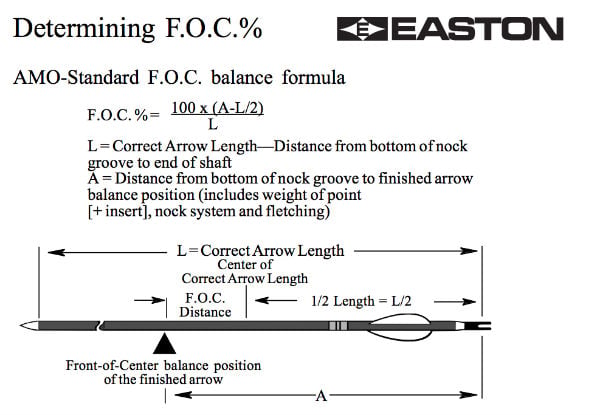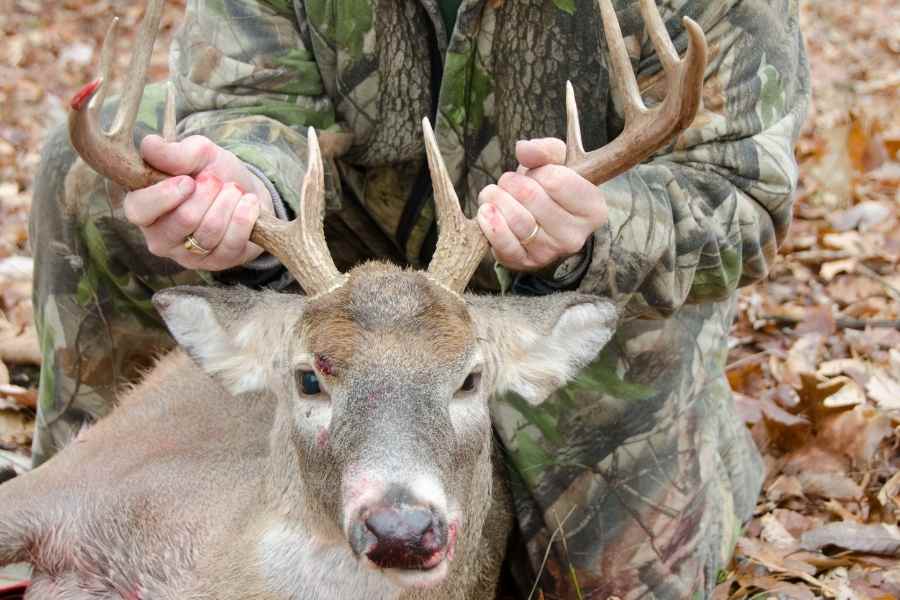Bowhunters typically use broadheads with a weight of 100 grains. No matter if you’re using mechanical broadheads or fixed blade broadheads, the 100-grain range will cover them all. For deer, 100-grain heads are plenty. But isn’t it obvious that heavier grains penetrate better? Why not go for 125-grain instead?
What you should ask yourself is, are your setup and equipment enabling you to achieve the ideal 12-18% F.O.C. (front of center) while experimenting with different broadhead weights?
Contents (Jump to Topic)
ToggleWhat is F.O.C.

“In the archery world, F.O.C. stands for “front-of-center.” FOC describes the percentage of the arrow’s total weight that is located in the front half of the arrow. The more weight that is located in the front half of the arrow, the more forward is the arrow’s center-of-balance.”
Source: https://eastonarchery.com/2014/06/foc/
Choosing a Good Broadhead Weight
Picking a good broadhead weight depends on your arrow weight, bow poundage, field tip grain, and your “normal” shooting distance. The weight of an arrow also directly affects the arrow speed, which is generally measured in FPS.
Most manufacturers offer 100-grain heads, and in combination with a carbon arrow, this gives you a decent weight broadhead for deer (and most other game). But why not heavier heads?
There is an excellent article over at Petersen’s Hunting that, in my opinion, explains very well why nowadays almost all broadhead manufacturers promote 100-grain heads.
Jeff Johnston says that “It wasn’t until sometime in the early 90s when the speed war between manufacturers began boiling over that 100-grainers even became popular.” he further goes on that due to the differences in IBO and AMO speed measuring, broadheads got lighter! Everybody got obsessed with arrow speed.
Source: https://www.petersenshunting.com/editorial/why-you-should-switch-to-heavier-broadheads/272022
AMO Speed (heavy)
- 60 pounds draw weight
- 30″ draw length
- 540-grain arrow for 9 grains per pound
IBO Speed
- 70 pounds draw weight
- 30″ draw length
- 350-grain arrow for 5 grains per pound
See where this goes? To stay within the IBO standards of the 350-grains total, a sufficient arrow for 70 lbs draw weight, and 30″ draw length, broadheads had to get lighter! Heavier broadheads would break the 350-grain limit…
125-Grain Broadhead – The Benefits?
As mentioned above, the majority of deer hunters use 100-grain broadheads. Maybe you are wondering what 25 grain more upfront will do? Are heavier heads better?
125-grain broadheads could (depending on your spine) increase F.O.C., long-range accuracy, and penetration. So if your bow has enough poundage, you might as well go for it. Nowadays, most bowhunters use laser rangefinders, a flatter trajectory, and guessing the distance is not that much of an issue anymore.
read.. broadheads for elk
Kinetic Energy
Heavier arrows (no matter the type of broadhead) will produce more KE and better momentum. An excellent article at goldtip.com talks about Kinetic Energy and how the speed and mass of the arrow influence its ability to penetrate a target. The heavier your arrow, the greater its potential penetration.
Here is an extract from their article:
“The measurable “power” of your bow – it’s total kinetic energy output – ultimately depends upon just two variables: the mass of the arrow and the speed of the arrow. Kinetic energy of an arrow can be found by using the formula KE=(mv²)/450,240 where m = mass of the arrow in grains and v = velocity of the arrow in fps. If your bow setup ultimately shoots a 400 grain arrow at a respectable 250 fps (a typical field-output for a modern rig), your actual kinetic energy or “power” will be:
KE=(mv²)/450240
KE=[(400)(250²)]/450240
KE=25000000/450240
KE=55.53 ft-lbs”
Source: https://www.goldtip.com/front-of-center-calculator
To effectively hunt deer, you aim for a minimum of a KE of 25-41 ft. lbs. Whereas anything below 40 ft. lbs probably won’t lead to a pass-through on a deer. But a well-placed short-range shot should be efficient nevertheless.
Make sure to check your local hunting regulations regarding minimum draw weight and broadheads.
The two main variables are arrow weight and arrow speed! If kinetic energy is your goal, heavier arrows are better than faster ones. The heavier the arrow, the more energy it can absorb from the bow and convert into kinetic energy. As the arrow takes more energy from the bow, less noise and vibration will be produced.
Read.. game carts
Summary
So, to answer the question, “What Grain Broadhead Should I use for Deer?” I would say that if your setup allows you to, you should shoot 125-grains over 100-grains. Increased FOC, better long-range accuracy, and better penetration outweigh drop by far. And if you are using a laser rangefinder – that shouldn’t be much of an issue anyway.
Always remember to practice with your setup first before going into the field.
So, are you using 100-grain heads? What is your arrow weight, field tip grain, and what bow poundage do you shoot? Tell us in the comment section below!







Conversation | 4 comments:
Hello, I am shooting a Easton axis340 5 mm that is 29” long. The arrow weighs 318.5 grains. 100 grain tip and 55# draw weight. Would going to a 125 grain broadhead be beneficial?
Absolutely, with your 55# draw weight, stepping up to a 125-grain broadhead might really up your game, especially if you’re eyeing larger quarry where that extra penetration and impact can make a big difference.
I am shooting a crntrrpoint patriot 425 wiyh 200 grain tip 200 lb draw weight
Would a 125 be beneficial over the 100 sverage shot distances are 45-55
Absolutely, considering the power of your setup and the distances you’re aiming for, opting for a 125-grain broadhead might indeed strike a nice balance. You’ll likely gain in terms of penetration without sacrificing too much speed or altering the trajectory dramatically. spend some time on the range to get a feel for how this change affects your shooting